July 29, 2019
 New development to update and renew buildings and parcels are a part of life in a city that wants to remain vital. In the last few decades, cities have put emphasis on encouraging mixed-use development, combining many types of uses in a space, from residential to cultural and commercial. But what exactly is mixed-use development and what are the benefits for a city and its residents?
New development to update and renew buildings and parcels are a part of life in a city that wants to remain vital. In the last few decades, cities have put emphasis on encouraging mixed-use development, combining many types of uses in a space, from residential to cultural and commercial. But what exactly is mixed-use development and what are the benefits for a city and its residents?
At its core, mixed-use development is just that: urban development that includes a number of different uses. When developing a piece of land, cities no longer want a large parcel of just offices or a large apartment building.The goal is more pedestrian-friendly development that combines residential/multifamily, retail, office and restaurant components. The idea is that this kind of development produces synergies in the use of the land, creating more of a walkable community that not only is good for the economy but also for residents and employees, as well as a destination for visitors to the neighborhood.
How Mixed-Use Development Benefits Residents and Tenants
People who live in cities want to have amenities close by. In a mixed-use development, they’re able to walk from their apartments and go to a restaurant, cafe or retail store, right at the bottom of their building or next door. Being able to walk to the things they want to purchase or experience saves them the costs of having a car to go everywhere, and with fewer cars on the road, the environment benefits. Public spaces are also incorporated into these developments, encouraging people to get outside and interact with other residents – fostering a sense of community. Similarly for people that work in office buildings in a mixed-use space, there are convenient places to eat, shop and relax during their lunch hour or after work.
Benefits of Mixed-Use to Developers and Investors
For developers and investors, mixed-use development because there are a variety of uses and tenants to these developments, this provides investors with diversification with regards to risk. There is no single, large tenant whose vacancy could negatively impact them. Certainly, there are a number of concerns that must be worked through such as parking and density regulations, so it’s important for developers to work with city planners as well as neighborhood groups early, as well. But by integrating a number of types of products, investors and developers will create destinations that will attract tenants of many kinds.
Mixed Use Development In Norwalk
Here in Norwalk, CT, the Waypointe development on West Avenue is a great example of mixed-use development. Included with apartments are dining and shopping establishments right downstairs. The development also has attractive public space and is within walking distance of the cultural attractions such as the Wall Street Theater, the Norwalk Public Library, the Lockwood Mathews Mansion, and Stepping Stones Museums, as well as other restaurants.
For cities, mixed-use development, integrating corporate, retail, entertainment, restaurants and residential, can encourage private investment, support business, promote tourism and increase tax revenue given the increased density. But the ultimate benefit and goal for a city is to help transform neighborhoods into destinations that bring residents, tenants and visitors to an area to live, work, shop and play.




